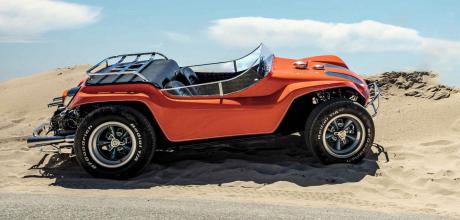1967 Meyers Manx The Thomas Crown Affair buggy
There’s cool, and then there’s driving Steve McQueen’s dune buggy on a California beach cool. Mark Dixon does his best to live up to the legend.
Photography Evan Klei
McQUEEN’S DUNE BUGGY
In California with the film-star Meyers Manx
KING FOR A DAY
The young couple in the Ferrari 360 are full of admiration as they pull up alongside us on the beachfront road. ‘Nice car, man!’ says the driver from behind his mirror shades. ‘Thanks!’ I reply. ‘We’re photographing it for a magazine — it’s the actual buggy driven by Steve McQueen in the movie The Thomas Crown Affair.’
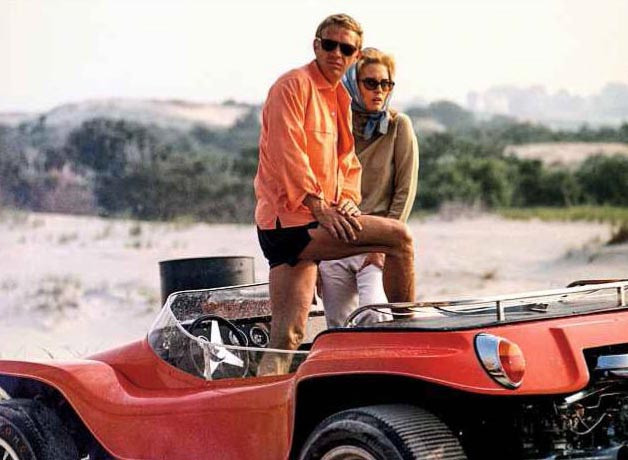
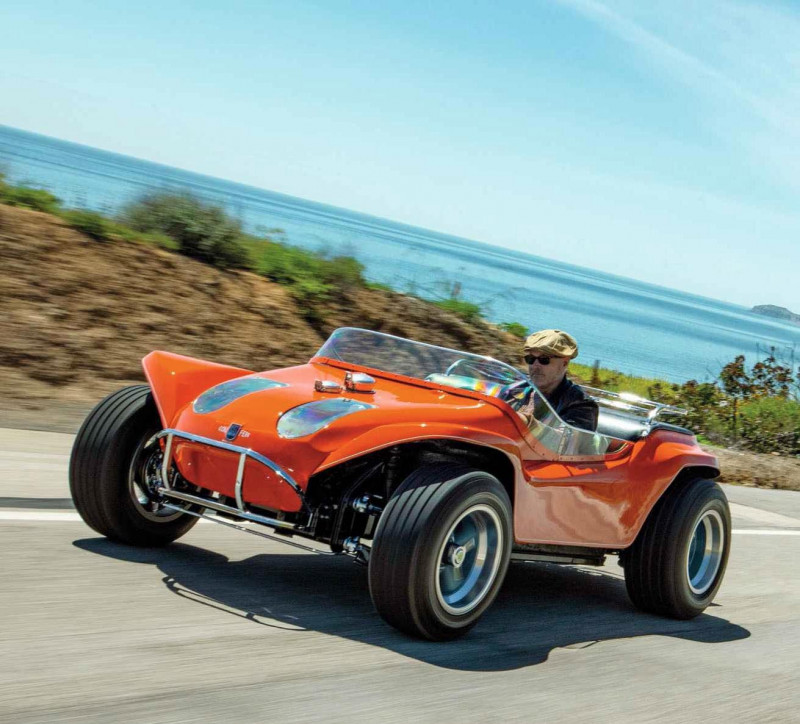
The guy pauses for a moment longer before nodding vaguely, and then he and his bleachblonde girlfriend are gone in a swirl of windblown sand. ‘They didn’t have a clue who I was talking about, did they?’ I remark to my friend and photographer Evan Klein. ‘Nope!’ he replies.
It’s a recurrent theme. As we grab some shots beside the Pacific Ocean, several passers-by compliment this Meyers Manx buggy, the epitome of Californian beach life. Each time we explain its significance, more often than not their slightly glazed expressions suggest they’ve never heard of Steve McQueen. Can this really be true? Has the King of Cool finally lost his crown?
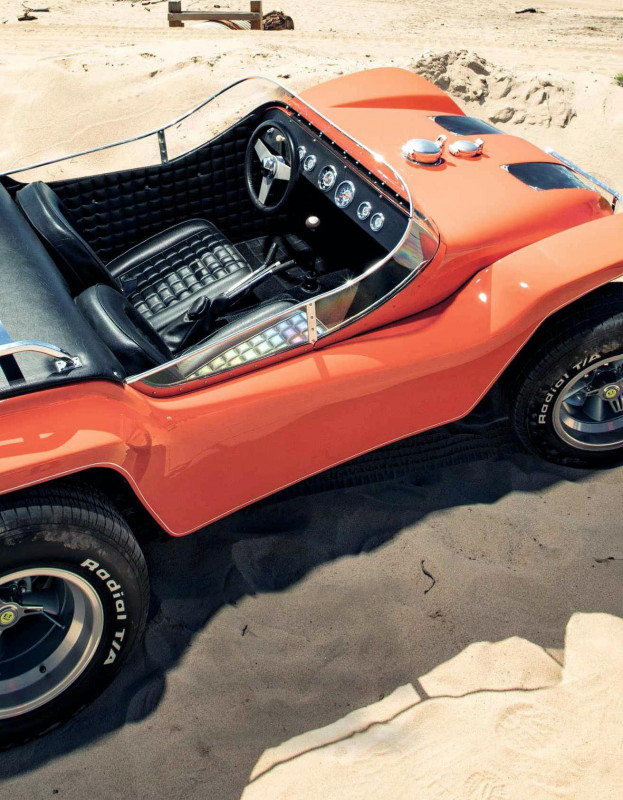
It’s hard to believe. I’ve just spent an hour blasting along the Pacific Coast Highway in Steve McQueen’s actual dune buggy. Let me repeat that: Steve McQueens actual dune buggy. It’s the focus of a key scene in the movie, when his character, the gentleman thief Thomas Crown, takes insurance investigator Vicki Anderson (played by Faye Dunaway) for a wild ride around the dunes in his customised Meyers Manx buggy. There are no stunt doubles here: McQueen yomps and drifts and handbraketurns the Manx with total abandon while Dunaway gamely attempts to stay in her seat, laughing all the while. Go girl!
‘We did one big jump for the camera right off the edge of a high dune, and it was wild… I looked over and Faye was all bug-eyed; the floorboard was scratched raw from her heels diggin’ in,’ McQueen said about the scene that opens this sequence. Then, later, he adds: ‘The throttle jammed and we were heading right for the ocean at a terrific rate of speed. Well, on film, all you could see was this orange bug disappearing into the water. Faye came out of it soaked and smiling. Some trouper! They had to take the whole engine apart to get the saltwater out.’
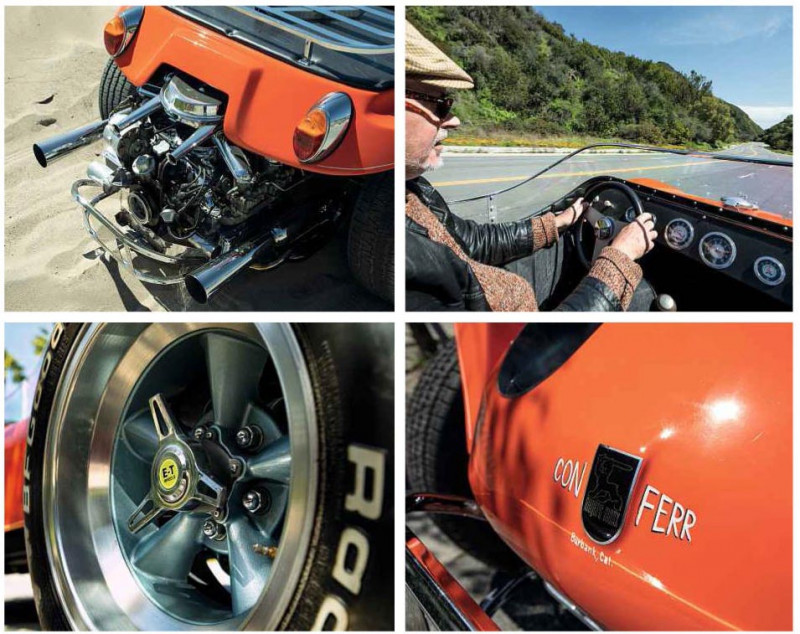
It will come as no surprise to learn that McQueen himself specced the Manx, and if you search on YouTube for ‘Steve McQueen Thomas Crown dune buggy’ you’ll find a short segment where McQueen himself talks about it over footage of him, bare-chested, tinkering with it on the beach.
‘I’m interested in engineering; I’m interested in geometries of suspensions, of motorcycles — this is my emotional outlet,’ he explains. ‘Crown lives at the beach and he has a sand-dune buggy; I helped ’em design it so I’m kind of proud of that. What it is, it’s sat on a Volkwagen chassis, with great ol’ wide weenies — big wide tyres on mag wheels — Corvair engine stuffed in the back, and a semi-reclining [driving] position, somewhat like on a Formula 1 car. It’s very light, you know; I think we’re on about 230 horses and the vehicle weighs about a thousand pounds.’
The beach scene was in fact filmed on Crane Beach in Ipswich, Massachusetts, in line with the East Coast setting of the movie — literally the other side of the country from where Bruce Meyers was building his dune buggies. Legend has it that the film-makers had originally pencilled in a Jeep for the scene, but McQueen wanted to use a Manx instead. He got his way.
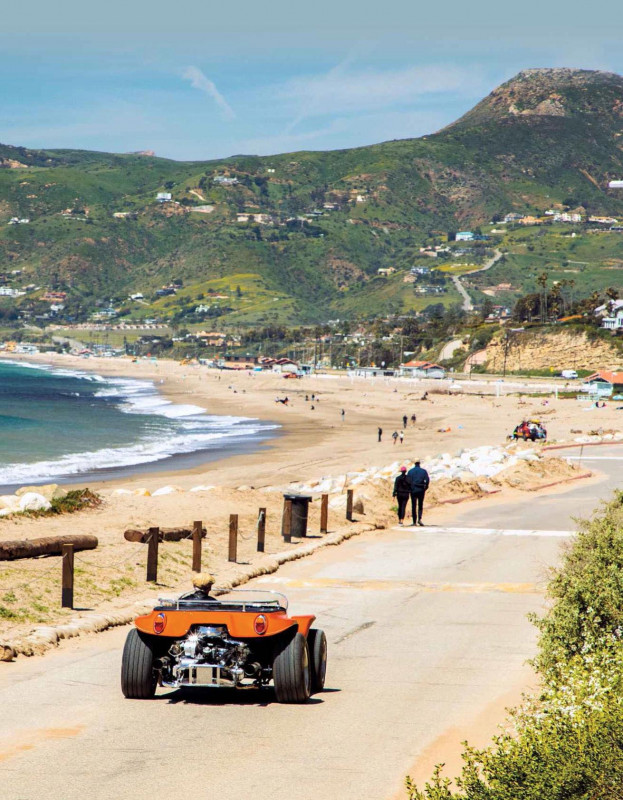
Bruce F Meyers built his original buggy in 1963-1964, designing a glassfibre monocoque to which a VW drivetrain and suspension were bolted. His production Meyers Manx — named after the tailless cat breed from the Isle of Man, because of its stubby appearance — incorporated a modified VW floorpan for simplicity and was sold in kit form from 1964 through to ’71, during which some 6000 bodies were produced. One of these bodies was sent at McQueens request to off-road specialist Con-Ferr Manufacturing in Burbank, California, for a custom build.
Former Con-Ferr employee Jon Harting later recalled: ‘I helped build the “Queen Manx” dune buggy that Steve drove in The Thomas Crown Affair… I bought a 1966 Corvair engine from a wrecking yard and brought it back to the shop and steam-cleaned it. We attached it to a VW transaxle that was in a VW chassis. The body was custom modified in our shop. I remember Steve coming by to look at its progress on two occasions… He was real nice to all of us there.’
As Harting describes, the most radical change to this particular Manx was the installation of a Chevrolet Corvair flat-six motor instead of the regular VW Beetle flat-four. Legend has it that McQueen asked for a Porsche engine but the budget wouldn’t run to it; nevertheless, even with a likely tuned-up 170bhp rather than McQueen’s claimed 230, that was a massive power increase over any Beetle unit’s.
As I’m about to find out, thanks to the generosity of the Manx’s current owner, collector Phillip Sarofim. At his Los Angeles storage facility I meet Zach Wegard, who helps with the collection, and take stock of the gleaming Manx. Straight away, you can tell that this is a one-off. The body sides go full-depth, unlike on a production Manx — apparently Bruce Meyers didn’t like the deep sides, since they prevented bodyshells being stacked — and the headlights are faired into the nose. Then there’s the shallow, boat-style Perspex windscreen that sweeps back either side of the cockpit, and the chromed custom-made boot-rack.
Climbing aboard requires care, thanks to that wraparound fixed windshield; you really have to resist the temptation to lean on its chromed finisher. Instead, step carefully onto the driver’s seat and slide under the tiny steering wheel. The custom trim is simple but beautifully done: quilted black Naugahyde (as someone once said, what the hell is a Nauga?) covering the body sides and seats, a plain black carpet over the floorpan and transmission tunnel. A curiosity — or, rather, two — is the pair of cranked levers, one either side of the central handbrake, which are ‘fiddle brakes’ specified by McQueen so that he could lock each rear wheel independently to encourage rear-end breakaway.
Your passenger has the better deal in terms of comfort, since the huge wheelarch intrusions mean that the driver’s pedal box is heavily offset to the right. Both of you can keep an eye on the set of Stewart Warner instruments spread across the dash, including a gauge to measure cylinder head temperature — a reminder that the Corvair engine, like the Beetle’s, is air-cooled.
The quad-carb flat-six fires immediately and settles to a lumpy idle, blat-blatting like, rather surprisingly, a hot Beetle flat-four. Inch out into LA traffic and a couple of things soon become apparent: one, this thing doesn’t like bumbling along at low revs, where the engine is decidedly fluffy; and two, the remote change is pretty vague. It doesn’t help that reverse has no lock-out, so it’s not difficult to select that instead of second. The good news is that you quickly learn to do it only once.
We stop/start in city traffic to Santa Monica before turning north onto State Highway 1, better known as the Pacific Coast Highway. On our left is the ocean, ahead there are long, curving stretches of dual carriageway — and the traffic has thinned considerably. Time to goose the throttle… Whooooo-ah! The exhaust note immediately hardens into a loud race-car rasp, the massive rear tyres grip the road like Velcro, and the Manx lunges forwards violently. By the time you shift into fourth the front end is starting to feel disconcertingly light. It’s hard to be sure just how fast you’re going because the speedo is over-reading, but a GPS check suggests 70mph is easily possible, if not relaxing.
There’s so much wind rush above the vestigial windscreen that the fabulous engine noise just gets swept away as you go faster, so I urge you to type ‘Thomas Crown Affair beach buggy scene’ into YouTube to get the full effect of the roaring, crackling exhaust as McQueen exhilarates Dunaway in a single minute’s worth of oversteery, spinny, splashy hooliganism.
Loose surfaces are the Manx’s natural home but, sadly if understandably, California’s beach patrols take a dim view of such activities and so we head inland to find a patch of scrubland where we’re not going to bother anyone too much.
Here, at last, it’s possible to throw the Manx around a little and play with it. With super-quick steering, the wheel set low like a dodgems between your knees, it’s just the most enormous fun. Minimal weight and wide, wide tyres — the rears are reputedly the same size as the ones used on Andy Granatelli’s STP Special Indy car — translate into a soft, pillowy ride, and the Manx is so squat and broad-hipped that it will skitter across the surface like a pond-skater. Even the least-talented wheelman driving a Meyers Manx on the loose can feel like he’s the King of Cool for a day.
Although McQueen was already A-list when The Thomas Crown Affair premiered in 1968, there was minimal interest in movie cars at the time, and the Manx was dumped in a United Artists’ lot in California. But then a car enthusiast in Hawaii called Jimmy Pflueger, who had been an early hot-rod pioneer just after World War Two and who went on to open the US’s first Honda dealership, decided he wanted it. His offer was accepted and he had the Manx flown over to Hawaii, rumoured to be still full of sand and salt from the filming at Crane Beach. When it arrived, he asked his mechanic to strip out the interior to make it lighter, and swap the Corvair motor for a VW 2.2-litre race engine. He then used it for sand racing. At some point the low-cut wraparound Perspex screen was also replaced with a conventional upright windscreen, and indicators were added.
Pflueger sold the buggy to another Hawaiian enthusiast, who also took it sand racing, as well as using it to tow water-skiers in shallow water. It was in a very sorry state when it next changed hands in 1997, swapped for a Mini Cooper S — and a shotgun. Its engine had seized, the body had been given several cheap blow- overs, and all the brightwork was rusty. The new owner didn’t get around to having it restored — at Bruce Meyers’ own Valley Center workshop — until the mid-2010s.
Then, in 2020, it was consigned to Bonhams’ Amelia Island auction, where a McQueen fan snapped it up for $456,000: a comparative bargain when you remember that McQueen’s Bullitt Mustang had sold for $3.74million just two months earlier. He contacted the Meyers Manx company now owned by uber-enthusiast of quirky and interesting cars, Phillip Sarofim, who agreed that it should be added to the business’s collection.
While you can’t buy a McQueen-spec buggy, the revitalised Meyers Manx is now offering brand-new, remastered Manx kits and even a fully electric version. But there’s nothing to stop you installing a full-fat Corvair motor, is there?
THANKS TO Phillip Sarofim, Allison Mahalic, Vreni Fernandez and Zach Wegard. For more information on the relaunched Meyers Manx, visit meyersmanx.com.
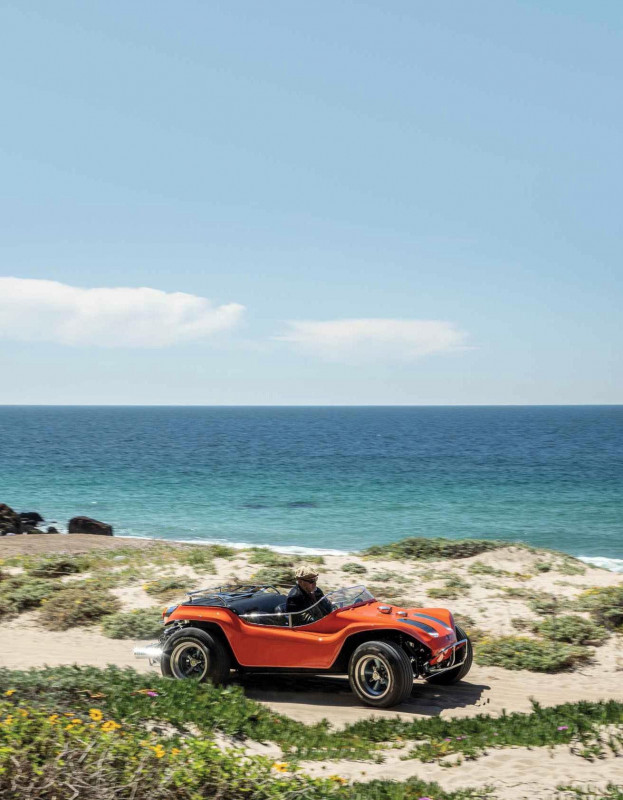
Above Wide stance, low centre of gravity and light weight combine to make the Manx sheer joy to throw about on a loose surface.
Above, clockwise from top left Corvair engine gives c170bhp; steering wheel set low; sign-written Con-Ferr badging on nose; super-wide rear magnesium alloys wear Indy-car-sized tyres.
TECHNICAL DATA 1967 Meyers Manx The Thomas Crown Affair buggy
- Engine 2683cc rear-mounted air-cooled Chevrolet Corvair flat-six, four Rochester carburettors
- Max Power 170bhp (est)
- Transmission Four-speed manual VW transaxle, rear-wheel drive
- Steering Worm and sector
- Suspension Front: beam axle, torsion bars, telescopic dampers, anti-roll bar. Rear: swing axles, torsion bars, telescopic dampers
- Brakes Drums
- Weight 550kg (est)
- Top speed 80mph (est)


